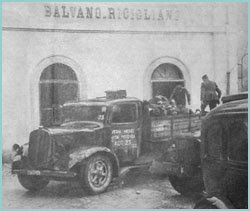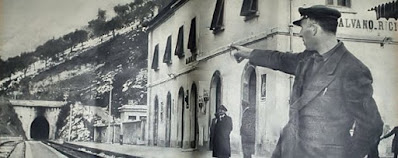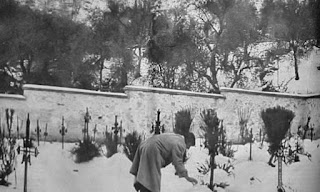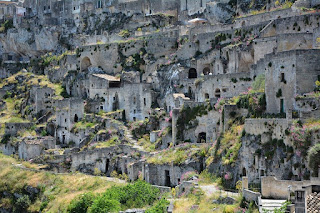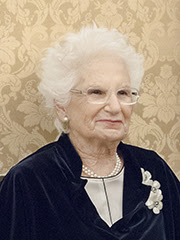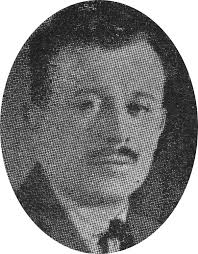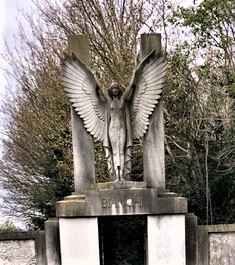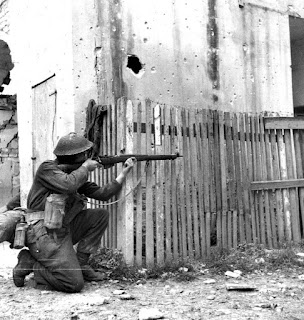Commander who was both decorated and imprisoned by the British
 |
| Bergonzoli's beard made him an instantly recognisable figure among Italian generals |
Bergonzoli had the distinction of being awarded a medal for bravery by the British during World War One only to be held by them as a prisoner of war after being captured during World War Two.
As a boy, Bergonzoli always had a taste for adventure. He completed a 1.5 mile (2.4km) swim across Lago Maggiore at the age of seven. He enrolled at the Military Academy of Modena, graduating with the rank of sub-lieutenant in 1907.
He joined the Royal Italian Army in 1911 and was immediately sent to take part in the Italo-Turkish War, helping to take control of the areas of the Ottoman Empire in Libya that became known as Italian Tripolitania and Cyrenaica, as well as some islands in the Aegean Sea. He remained in Libya for some years after the conflict.
In the First World War, after initially declaring neutrality, Italy sided with Britain, France and Russia against Germany and Austria-Hungary and Bergonzoli was awarded the British Military Cross for bravery for his defence of Monte Rovegno in Liguria. He had a prominent role in the Salonika Campaign in the Balkans, in which he became part of the Allied High Command as a combined force of Austria, Germany and Bulgaria was defeated.
 |
| Some of the 30,000 Italians taken prisoner following the damaging defeat at Bardia |
When the Fascists took control of Italy in 1922 and reformed the army, Bergonzoli retained his rank and was put in control of three regiments.
Elevated to Brigadier General in 1935, he participated in the Italian invasion of Ethiopia, playing a major role in the capture of the city of Neghelli as Italy annexed the country to the Kingdom of Italy.
Commended by Benito Mussolini, the Fascist leader who was by then ruling Italy as a dictator, he was then sent to Spain as the head of an infantry division of the Corpo Truppe Volontarie, an expeditionary force sent to support Franco in the Spanish Civil War. He was awarded the Gold Medal of Military Valour by Mussolini for leading the capture of Santander on behalf of Franco’s nationalists.
Further promoted to Major General and then Lieutenant General, Bergonzoli, he was put in charge of the XXIII Italian Army Corps as an Italian invasion of Egypt was attempted in World War Two, in which the British were now his enemies.
He fared less well this time. He was commander of the Italian garrison in Bardia, a strongly defended seaport in the east of Libya, close to the border with Egypt, that fell in January 1941 following an assault by a combined force of British and Australian troops.
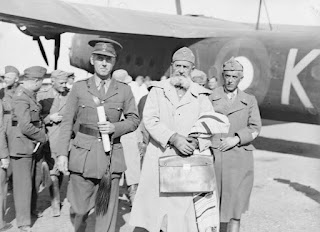 |
| The captive Bergonzoli with other Italian officers after disembarking at Cairo in February, 1941 |
As the Allies advanced into Libya, he left Tobruk before the town was captured, retreating further to the west, but as the Italians prepared to evacuate they were engaged again at Beda Fomm on the Gulf of Sirte. This time, Bergonzoli was taken prisoner by Australian troops among 25,000 more Italian personnel.
As a prisoner of war, Bergonzoli was taken first to Yol, a British camp in India, in the far north of the country towards the Himalayan mountain range, and then transferred to the United States, to be held first in Monticello, Arkansas and later Hereford, Texas.
After the Italian surrender and the armistice of September 1943, Bergonzoli refused any form of collaboration with the Anglo-Americans, who in turn refused to allow him to return to Italy, declaring him mad and holding him for a further two and a half years in the psychiatric ward of the Long Island military hospital, New York.
Finally released in March 1946, he was reinstated to the army of the new Italian Republic and given the rank of lieutenant general in 1947 before being permanently discharged later that year at the age of 62.
In retirement, Bergonzoli returned to live in Cannobio until his death in May, 1973. He is buried in a modest tomb at the town’s cemetery.
 |
| Cannobio is a pretty town on the western shore of Lago Maggiore, not far from the Swiss border |
Cannobio, where Bergonzoli was born and died, can be found on the western shore of Lago Maggiore towards the northern end of the lake, only a few kilometres from the border between Italy and Switzerland. It is regarded as one of the prettiest towns on the western side of the lake, with a long waterfront, the centrepiece of which is the lakeside Piazza Vittorio Emanuele, which was refurbished in 2004 and completely relaid in cobblestones and granite slabs. In history, the people of Cannobio are remembered for their bravery in repelling an Austrian attack in 1859, while fighting on the side of Giuseppe Garibaldi during the struggle for unification, and for rising up against the Nazi and Fascist regime in 1944.
 |
| The Baroque 17th century Ducal Palace, which dominates the skyline of the city of Modena |
The military academy where Bergonzoli enrolled as a young would-be soldier is today Italy's national military academy. It is housed within Modena’s huge, Baroque Ducal Palace, the prominent feature of the city’s skyline, which was built in the 17th century by the architect Luigi Bartolomeo Avanzini on behalf of Francesco I on the site of a former castle in 1635. Modena, on the south side of the Po Valley in the Emilia-Romagna region of Italy, is known for its car industry - Ferrari, De Tomaso, Lamborghini, Pagani and Maserati have all been located there - and for producing balsamic vinegar. Operatic tenor Luciano Pavarotti and soprano Mirella Freni were both born in Modena.
Also on this day:
1512: The first public viewing of Michelangelo’s ceiling frescoes in the Sistine Chapel
1546: The death of painter and architect Giulio Romano
1596: The birth of painter and architect Pietro da Cortona
1757: The birth of sculptor Antonio Canova






